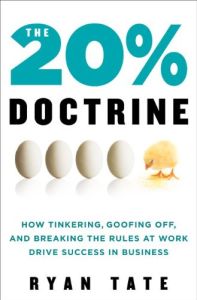Join getAbstract to access the summary!

Join getAbstract to access the summary!
Ryan Tate
The 20% Doctrine
How Tinkering, Goofing Off, and Breaking the Rules at Work Drive Success in Business
HarperBusiness, 2012
What's inside?
Rekindle your company’s potential by letting your employees run wild.
Recommendation
Veteran business journalist Ryan Tate explores how firms generate innovation based on Google’s approach, which allows employees to spend 20% of their paid time on personal projects. Google’s idea migrated to Flickr, Yahoo, and nontechnological environments such as journalism, education and food service. Although this model is not viable for every business, Tate demonstrates its applicability across a variety of industries. He explains how to turbocharge your workers’ creativity with unbridled camaraderie, “kamikaze deadlines” and possibly absurd expectations. getAbstract recommends Tate’s primer to managers who want to inspire their workers and to workers who are already inspired and just need a little time.
Summary
About the Author
Ryan Tate is the technology gossip blogger for Gawker’s website and a veteran business journalist. Approximately 700,000 people read his posts each month.


















Comment on this summary